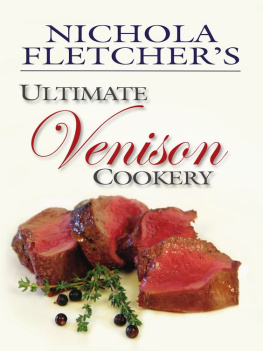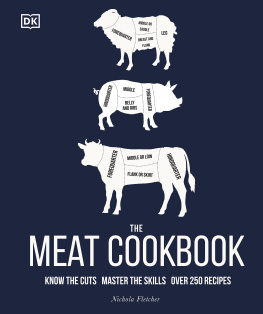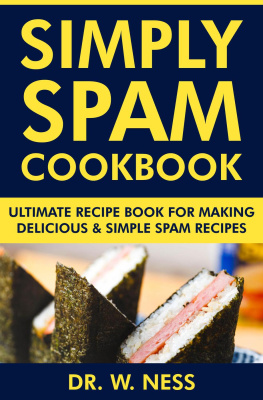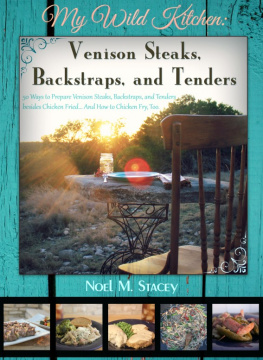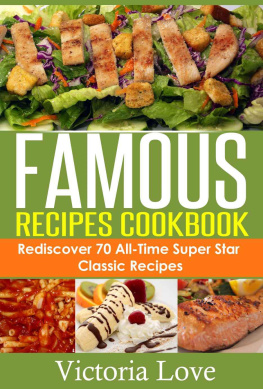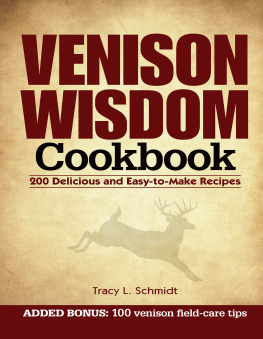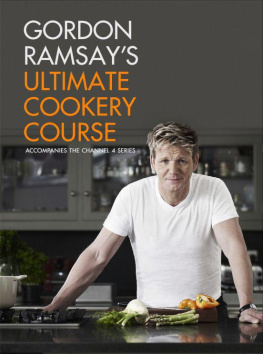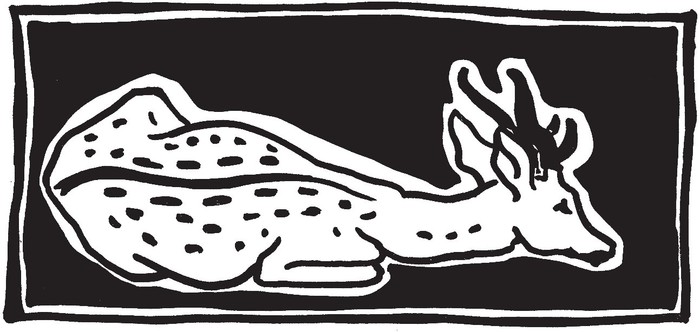A book that is the distillation of thirty years work is clearly the spirit of many peoples generosity. There are so many, and some sadly no longer with us, that it is impossible to list them individually. It was Sue Varvill of the British Deer Society who urged me to produce this book, and finally, in impatience at my inertia, put me in touch with Andrew Johnston and his team at Quiller Publishing, so to The British Deer Society and to Sue in particular I remain grateful. There are many other societies which have helped with information and enthusiasm: The Veterinary Deer Society, who in return for some convivial venison banquets have always provided balanced scientific advice; the Game Conservancy in Scotland, for whom I have demonstrated venison and game cooking at the Scottish Fair for more years than I care to remember. And, of course, the British Deer Farmers Association, with whom we have discovered and worked out many fascinating things about deer and venison.
Our international network of friends can always be relied upon to provide specialist knowledge. They come from Britain and Europe, from New Zealand and Canada, from Australia and America, from Persia and China. Ecologists, researchers, veterinarians, deer farmers, park managers, stalkers, game dealers, wildlife rangers, chefs, writers, historians, factors and academics, not to mention the eager team of voluntary recipe testers you know who you are, and I thank you all. Food writers relish discussions about the delicious world of food production, ingredients, cooking, and eating, and I am no exception. So to my learned international friends at Eat Words, and to colleagues at The Guild of Food Writers, I raise my glass in companionship. I should also like to acknowledge the many newspaper, radio and television journalists who greeted our stories with such enthusiasm. Without them, the task of spreading the word about venison would have been more difficult.
Probably the largest group I should acknowledge here is our loyal army of customers who over the years have been so positive in their feedback. Through them, I have learnt what people like, dont like, wish for, feel uncertain about, and want to know more about, when it comes to venison. I have relived memorable meals with them, had fun planning new ones, celebrated successes in cookery competitions, helped their pets back to health, shared stories and discussed a myriad of interesting topics. I realise how lucky I am to have such appreciative and communicative customers.
Finally, I should like to give three cheers for our excellent team here: for Graeme Braid, our master butcher who stood, knife poised, as I made diagrams; for David Stewart who looks after our deer so conscientiously; and for Pauline who helps in the butchery, farmers markets and in the office. Our daughters Stella and Martha remain in touch with the farm, to our delight. But it is John, The Ships Captain who deserves my gratitude most of all, for without him there would have been no voyage of venison, and no book.
The sheer pleasure of venison
There are very few things in life that you can enjoy doing and are also good for you. I can only think of two, and one of those is eating venison.
John Fletcher
When it comes to choosing what meat (or indeed food) to cook, there are many positive aspects to venison. Apart from the fact that it is delicious and offers significant health benefits, there is much to offer the conscience as well as the body an increasingly important aspect for people who want to feel reassured about what they eat as well as enjoy its taste.
I wrote my first venison cookery book in 1983. A novice at food writing, I produced it in response to questions from customers eager to know how to cook it. John and I had been producing venison for ten years by then, selling it directly to people in Britain instead of exporting it, as most game dealers did at the time. When we started working with our deer in 1973, restaurants that featured venison on their menu were rarities, and of those that did, too many dished up overcooked roasts or stewed it to a stringy death. Consumers had barely heard of venison, far less eaten or cooked it. English market stalls and a few specialist shops were the only places to buy it if you didnt shoot your own. Those that had heard of venison were full of anxieties, many of them perfectly understandable given some of the misconceptions current at the time. And a tragic number of people came to us with horror stories of uneatable venison that even their dogs wouldnt touch. Actually they still do, but thankfully not very many. We had a lifetimes task ahead of us to change all that, but thirty years of exploration and discovery have been a privilege. They took us all over the world, into generous peoples homes, to parks, estates, ranches and farms, to research institutes, deer societies, game larders, hunting communities, and sometimes into politicians lairs. We found that the world of venison is populated with larger-than-life characters. Sometimes we revised our original opinions, sometimes we had them reinforced, invariably we learned something entirely new. Always the deer were there with us, teaching us, and they still are.
Much has changed since those early days. More venison is now sold within Britain than exported. Indeed, the demand is topped up with farmed imports from New Zealand. Throughout America and Europe, wild deer are hunted less and numbers are increasing so fast that in some areas they are causing environmental damage and need heavier culling. Fortunately, consumption is increasing all over the world. Venison is commonly seen on restaurant and bistro menus, with a new generation of chefs keen to try out innovative recipes. Venison lends itself well to a wide variety of dishes, and the imagination of these chefs has inspired their customers to try cooking it at home. Farmers markets have brought venison regularly into many town centres, along with people able to give advice. Even the much-maligned supermarkets have played their part, though I do wish they would not instruct people to overcook it more of that later.
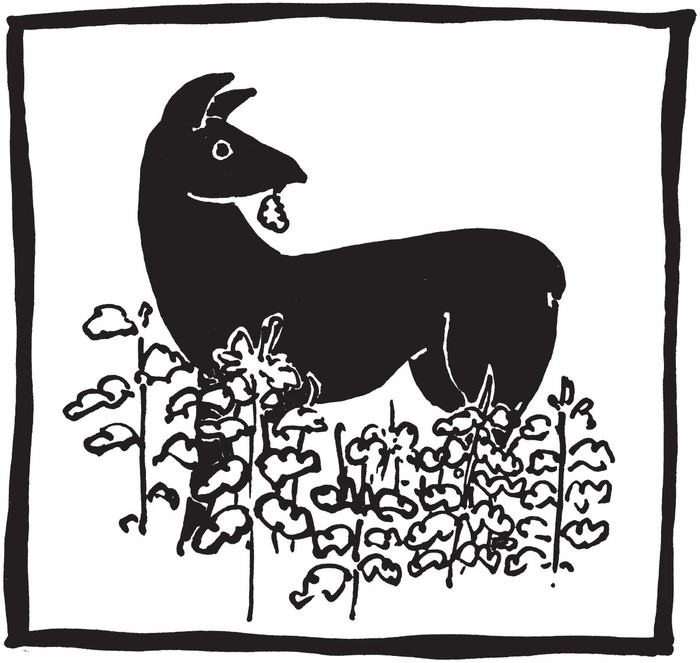
But, but we havent quite got there yet. The journey is not finished. There is still incorrect advice churned out. Writers still come out with astonishing pronouncements that are either quite wrong or miss the point completely. Are these statements based on a single experience or simply prejudice? Whichever it is, those mantras of misinformation are copied from one erroneous publication to the next. As a result, too many people still labour under hoary old myths which ruin their dishes, missing the infinitely more interesting and delicious truth. There is still a deep lack of knowledge in some parts of the catering trade. There are still some game dealers, processors and butchers who throw their normal high standards out of the window when confronted with a deer carcase. And there are still thousands of people who have not yet experienced this exceptional meat, for which the only essential ingredient is an open, enquiring mind.
One of the biggest differences between venison and conventional domestic meat is that it comes from deer of very different sizes, ages, sources and species so it helps to understand the effects these could have on the cooking. And being so lean, it sometimes needs different cooking methods from the fattier meats most people are used to dealing with. No one can successfully recreate dishes from a foreign country without information about the cooking methods, the culture and how the ingredients react to cooking. And for many people, the world of venison is a foreign land. So I make no apology for including the necessary technical information. On the contrary, the more you know about what you are cooking and eating, the more you enjoy it. It makes good dinner conversation, too.

